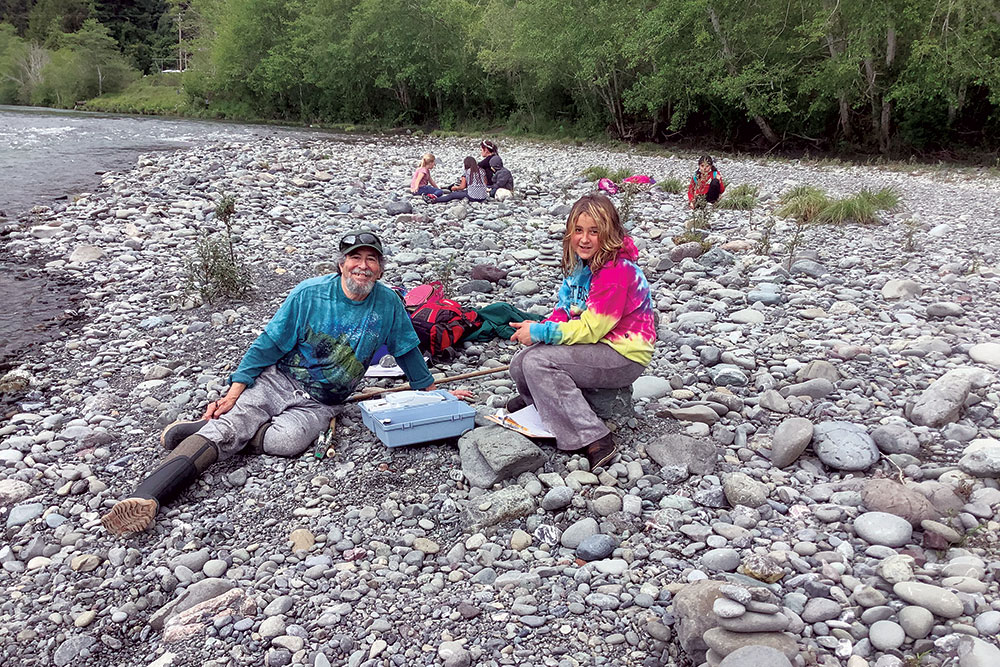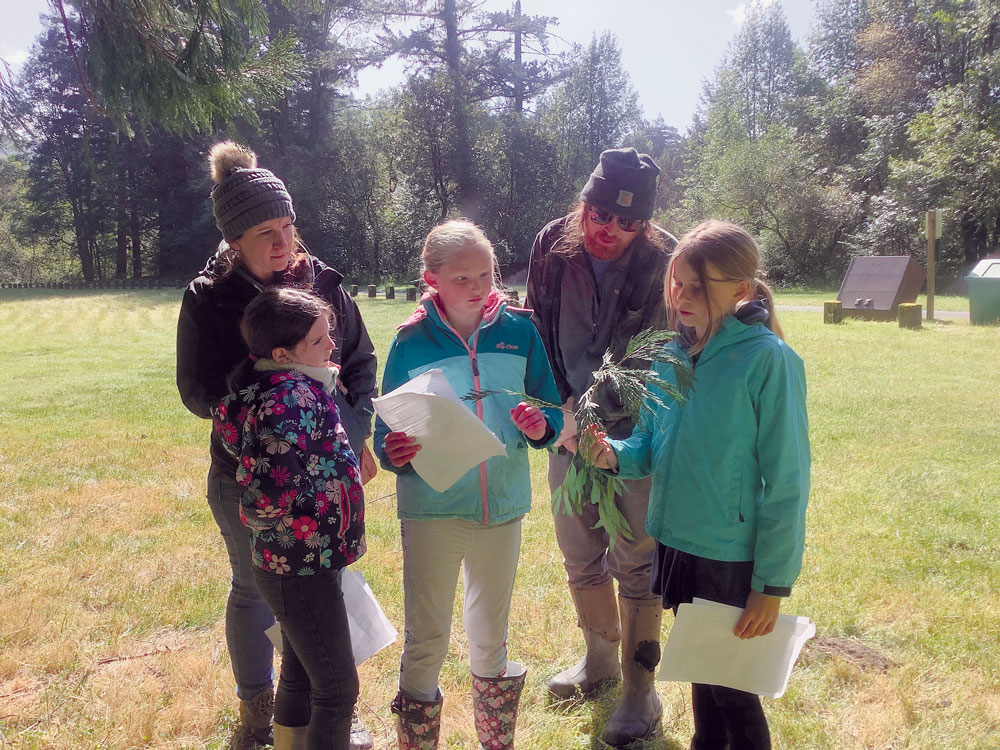Nurturing Nature: Adventures of the Friends of the Van Duzen River

Friends of the Van Duzen River
By Sal Steinberg
Special thanks to the rain gods for bringing the Van Duzen and Eel Rivers back to a much healthier state of being this spring.
Friends of the Van Duzen River (FOVD) spent several busy spring months working with five schools—Bridgeville, Hydesville, Loleta, Scotia, and Trillium Charter—and conducting two water-monitoring projects in the Eel River, at Scotia and at Worswick between Fortuna and Fernbridge.
Connecting Elementary School Kids to their Inner Scientific Self
There is a certain beauty working with elementary school kids and teaching them about nature in the classroom and in the field while connecting them to their inner scientific self. At Loleta, Kurt Rasmussen’s first-grade class was a delight! Working closely with Loleta’s staff artist, Abby Perrott, and Kurt’s aide, Luz Espinosa, students learned botany by drawing leaf structures brought to them to study, and then going out into the field at Loleta School to sketch flowers. We followed this up with salmon lessons. When presented with an 11×14” outline of a salmon, students did a wonderful job coloring it. We brought the experience to life by going to the Scotia Aquarium, concentrating on counting and understanding fins and their structure, and then doing the Salmon Dance. This can be viewed at the FOVD website www.fovd.org
FOVD had a similar experience with the K-2 class at Bridgeville Elementary where students learned about water and salmon, and originated the Salmon Dance, in which they learned to move their bodies like fins. Be The Fish!! They also experienced the Scotia Aquarium. Special thanks to Mike Connich, Humboldt Redwood Company, for maintaining and keeping alive the aquarium as an educational medium.
Working closely with Rachel Riggs’ combo third/fourth-grade class at Hydesville, we studied the nature of water, the concept of a watershed, and the natural history of salmon. We also did a study of plants that culminated in viewing and experiencing the trillium blossoming in the redwood forest. On our field trip to the Van Duzen River in March, students combined science and art by drawing the beautiful trillium. Working with Barbara Domanchuk on Geology, and with Tony Westcamper on Insects, students had a great field trip. In April FOVD joined these students at Pamplin Grove for Barbara’s annual Save the Redwoods field trip experience.

Training Young Scientists
FOVD is dedicated to preserving the salmon run and to training young scientists. In the third/fourth-grade class at Loleta Elementary, students participated in the Humboldt County project of raising salmon eggs in the classroom. In mid-year, teacher Sarah Strauss transferred schools and Emily Parshall took over the class and the project. I collaborated with her in maintaining the tanks, teaching about steelhead, and transferring the fingerlings to the Mad River for the annual fish release. It is always a memorable experience to raise and release living things back into their environmental homes. While watching them grow, students would “adopt” one of the 25 as their own. This process is always a wonderful time for kids, allowing them to be a vivid part of the life process of another organism.
It is always exciting to teach in a new school in Humboldt, and recently FOVD had the opportunity to teach at the Trillium Charter School, in Katie Dunn’s second- to fifth-grade classroom. Students learned about water, salmon, and how to test the river for temperature and pH. They did salmon illustrations and wrote acrostic poetry. They were very creative and an excellent learning group.
FOVD has specialized in water monitoring in the Van Duzen and Eel Rivers since receiving the nonprofit group’s first major California Fish and Wildlife grant in 2007. Maintaining a healthy river system is essential to preserving the cyclical salmon and steelhead runs. The severe drought this past fall and winter posed a huge problem to the life cycle of these endangered species. Fortunately, as our testing showed in May, sections of the Eel and the Van Duzen have returned to a better state of health.
In Mark McCuen’s sixth-grade class at Scotia, and Heather Nyberg’s fifth- and sixth-grade combo class at Loleta, FOVD did extensive training with students in the use of water-monitoring equipment for temperature, pH, turbidity, and dissolved oxygen. These are all important components and indicators of river quality. Using YouTube videos to help explain these concepts, discussions about optimal conditions for salmon in local streams, and testing their school water and other water samples, students learned the major concepts of water-quality monitoring and how to use the equipment in their classrooms.
Then it was time to go into the field. For many kids, just being by the river is a wonderful event and an important part of their learning experience. On May 16th in the Eel River near Scotia, we divided into two groups with Mark working with nets, river exploration, and macroinvertebrates. They found the following: 2 water pennies, 1 crayfish, 20 mayfly, 3 planarian, 3 scud, 6 riffle beetles, clam shells, and snails. On the other side, the intern Brian Feurman from Academy of the Redwoods helped gather test results that showed perfect pH between 7.2 and 7.8, turbidity water quality ranging between 2 and 10 which was very clear, and water temperature at a healthy range between 59 and 61. It was a fun day!
For our Loleta field study on May 20th we investigated the Eel River at the Worswick hole between Fortuna and Fernbridge. We were joined by five members of the Fortuna Creeks Project (FCP), a nationally renowned environmental group from Fortuna High School led by Mark Thom, Jacey Spies, and Gloria Valdez. Brian Feurman again joined us, this time to make a movie of the field trip. This site was a bit marshier than the Scotia site. Once again pH ranged between 7.2 and 7.8, turbidity between 2 and 9, and water temperature was higher at 64. FCP added nitrate and phosphorus testing, with results between 0-2 showing no fertilizer runoff. Dissolved oxygen ran from 4 to 7 with 7-8 being optimal.
Being out in Nature is the ultimate environmental learning experience for students! FOVD is proud to be a part of this process.
For More Information: www.fovd.org
